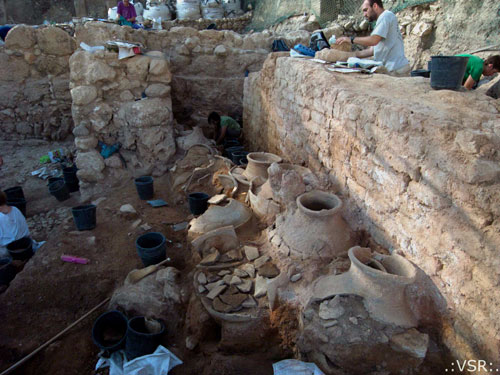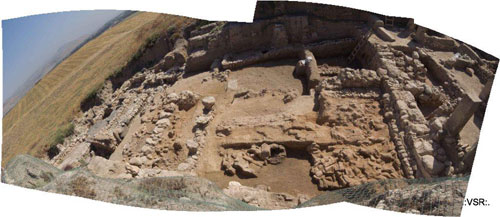(Communicated by the Israel Ministry of Tourism)
14 large clay jugs containing seeds of 3,400 year old burnt wheat have
recently been uncovered in a storage room at Tel Hazor in the Upper Galilee during
excavations being conducted under the auspices of the Hebrew University of
Jerusalem and the Israel Nature and Parks Authority.


Photo: Sharon Zukerman
Tel Hazor, a national park, has long been recognized as one of the country's
most important archaeological sites. From the 18th to the 9th centuries BCE, it
was the largest fortified city in the country and had commercial ties with both
Babylon and Syria. The Book of Joshua describes Hazor as the “head” of several
kingdoms that united to fight the Israelites. In 2005, Tel Hazor was designated
a UNESCO World Heritage Site.
In recent years, the archaeological digs at Tel Hazor revealed a monumental
structure, which scholars believe to be the royal castle of Hazor, dating back
to the Canaanite Period (third to second millennium BCE. According to Professor
Amnon Ben-Tur of the Hebrew University, who has been in charge of the Hazor
excavations since 1990, the jugs were destroyed around the 13th century BCE, a
period which coincided with the biblical account of Joshua’s capture of Hazor.
According to Chapter 11 in the Book of Joshua, Hazor was the only city in the
Land of Israel that was destroyed by fire during the conquest.


Panoramic view of Tel Hazor (Photo: Sharon
Zukerman)
Scholars are at odds as to when Hazor was destroyed and by whom. While the
most widely accepted school of thought accepts the theory that Hazor was
destroyed by the Israelites in or around the 13th century BCE, there are many
scholars who hold that Hazor was destroyed by either the Egyptians, the Sea
Peoples, or nomadic tribes that wandered the region at the time.
According to Ben-Tur, however, Hazor was not included in any of the lists of
Israelite cities destroyed by the Pharaohs and the Sea Peoples - who
traditionally stayed close to the coastline - would not have conquered a city as
far inland as Hazor. Ben-Tur contends that this recent discovery at Hazor “sheds
even more light on Israelite history.”